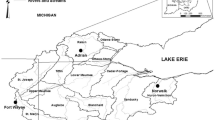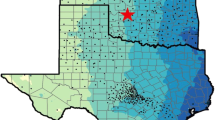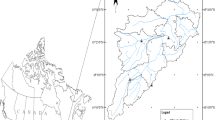Abstract
Weather generators are increasingly used in environmental, water resources, and agricultural applications. Given their potential, it is important that weather generators be evaluated, particularly with respect to their ability to capture extreme events. This study was aimed at evaluating weather generator representation of climate extremes with a focus on LARS-WG applied to three stations in the Western Lake Erie Basin, U.S. Generally, LARS-WG captured the number of days with precipitation greater than 50.8 mm (2 in. and 101.6 mm (4 in), 7-day wet sequences, and wet and dry sequences relatively well. The distribution of 1-day maximum precipitation was also generally captured well based on Q-Q plots, although large deviations were seen at the upper tail at one of the stations. The generator greatly underestimated the number of days per year with maximum temperatures greater than 32.2 °C (90 °F) and overestimated the number of days with temperatures less than 0 °C (32 °F). It also underestimated spring and summer values of one-day maximum temperatures across all stations. Fall and winter values were, however, captured fairly well as were seasonal values of one-day minimum temperatures. Overall, the generator performed relatively well in representing extremes within the basin.


Similar content being viewed by others
References
Acharya N, Frei A, Chen J, DeCristofaro L, Owens EM (2017) Evaluating stochastic precipitation generators for climate change impact studies of New York City’s primary water supply. J Hydrometeorol 18(3):879–896. https://doi.org/10.1175/JHM-D-16-0169.1
Al-Mukhtar M, Dunger V, Merkel B (2014) Evaluation of the climate generator model CLIGEN for rainfall data simulation in Bautzen catchment area, Germany. Hydrol Res 45(4–5):615–630
Blevins DW (2011) Water-quality requirements, tolerances, and preferences of pallid sturgeon (Scaphirhynchus albus) in the lower Missouri River: U.S. Geological Survey Scientific Investigations Report. Reston, Virginia, pp 2011–5186
Brisson E, Demuzere M, Willems P, van Lipzig NPM (2015) Assessment of natural climate variability using a weather generator. Clim Dyn 44(1–2):495–508
Caron A, Leconte R, Brissette F (2008) An improved stochastic weather generator for hydrological impact studies. Can Water Resour J 33:233–256
Chen J, Brissette FP (2014) Comparison of five stochastic weather generators in simulating daily precipitation and temperature for the loess plateau of China. Int J Climatol 34(10):3089–3105
Chen J, Brissette FP, Leconte R (2012) WeaGETS– a Matlab-based daily scale weather generator for generating precipitation and temperature. Procedia Environ Sci 13:2222–2235
Dalgaard P (2008) Introductory statistics with R. Springer Science+Business Media, LLC, New York
Eames M, Kershaw T, Coley D (2012) A comparison of future weather created from morphed observed weather and created by a weather generator. Build Environ 56:252–264
Elliot W, Arnold C (2001) Validation of the weather generator CLIGEN with precipitation data from Uganda. T ASAE 44:53–58
Epstein Y, Moran DS (2006) Thermal comfort and the heat stress indices. Ind Health 44(3):388–398
Fan JC, Yang CH, Liu CH, Huang HY (2013) Assessment and validation of CLIGEN-simulated rainfall data for northern Taiwan. Paddy Water Environ 11(1–4):161–173
Farzanmanesh R, Abdullah AM, Shakiba AR, Amanollahi J (2012) Impact assessment of climate change in Iran using LARS-WG model. Pertanika J Sci Technol 20(2):299–311
Fatichi S, Ivanov VY, Caporali E (2011) Simulation of future climate scenarios with a weather generator. Adv Water Resour 34(4):448–467
Fodor N, Dobi I, Mika J, Szeidl L (2013) Applications of the MVWG multivariable stochastic weather generator. Sci World J 2013:1–6. https://doi.org/10.1155/2013/571367
Gitau MW, Chiang LC, Sayeed M, Chaubey I (2012) Watershed modeling using large-scale distributed computing in condor and the soil and water assessment tool model. Simulation 88(3):365–380
Gitau MW, Mehan S, Guo T (2017) Weather generator utilization in climate impact studies: implications for water resources modeling. European Water 59:69–75
Griffin D (undated) Feedlot heat stress checklist. University of Nebraska, Great Plains Veterinary Educational Center. Available at: http://gpvec.unl.edu/heatdrought/flheatsr.pdf. Last accessed November 2017
Guo T, Mehan S, Gitau M, Wang Q, Kuczek T, Flanagan D (2017) Impact of number of realizations on the suitability of simulated weather data for hydrologic and environmental applications. Stoch Env Res Risk A. https://doi.org/10.1007/s00477-017-1498-5
Hensel DR, Hirsch RM (2002) Chapter A3: statistical methods in water resources. In: Techniques of water-resources investigations of the United States Geological Survey. Book 4 Hydrologic Analysis and Interpretation. U.S. Geological Survey. Available at: http://water.usgs.gov/pubs/twri/twri4a3/. Last accessed November, 2017
Hundecha Y, Pahlow M, Schumann A (2009) Modeling of daily precipitation at multiple locations using a mixture of distributions to characterize the extremes. Water Resour Res 45(12). https://doi.org/10.1029/2008WR007453
Jolliffe IT, Stephenson DB (eds) (2012) Forecast verification: a practitioner’s guide in atmospheric science, 2nd edn. Wiley, UK
Kalnay E, Hunt B, Ott E, Szunyogh I (2006) Ensemble forecasting and data assimilation: two problems with the same solution? In: Palmer T, Hagedorn R (eds) Predictability of weather and climate. Cambridge University Press, Cambridge, p 2006
Karl TR, Knight RW, Easterling DR, Quayle RG (1996) Indices of climate change for the United States. B Am Meteorol Soc 77(2):279–292
Klein Tank AMG, Können GP (2003) Trends in indices of daily temperature and precipitation extremes in Europe, 1946–99. J Clim 16(22):3665–3680
Klein Tank AMG, Zwiers FW, Zhang X (2009): Guidelines on analysis of extremes in a changing climate in support of informed decisions for adaptation. WCDMP-72, WMO/TD-1500, Available at www.wmo.int/datastat/documents/WCDMP_72_TD_1500_en_1_1.pdf. Last accessed February, 2018
Kou X, Ge J, Wang Y, Zhang C (2007) Validation of the weather generator CLIGEN with daily precipitation data from the loess plateau, China. J Hydrol 347(3):347–357
Kyselý J, Dubrovský M (2005) Simulation of extreme temperature events by a stochastic weather generator: effects of interdiurnal and interannual variability reproduction. Int J Climatol 25(2):251–269
Lemann T, Zeleke G, Amsler C, Giovanoli L, Suter H, Roth V (2016) Modelling the effect of soil and water conservation on discharge and sediment yield in the upper Blue Nile basin, Ethiopia. Appl Geogr 73:89–101
Mehan S, Guo T, Gitau M, Flanagan D (2017) Comparative study of different stochastic weather generators for long-term climate data simulation. Climate 5. https://doi.org/10.3390/cli5020026
Midwestern Regional Climate Center, MRCC (2017). Midwest Climate: Climate Summaries. Available at: http://mrcc.isws.illinois.edu/mw_climate/climateSummaries/climSumm.jsp. 2014–2017. Last accessed November, 2017
Min YM, Kryjov VN, An KH, Hameed SN, Sohn SJ, Lee WJ, Oh JH (2011) Evaluation of the weather generator CLIGEN with daily precipitation characteristics in Korea. Asia-Pacific J Atmos Sci 47(3):255–263
Mithen S, Black E (2011) Water, life and civilisation: climate, environment and Society in the Jordan Valley, international hydrology series. Cambridge University Press, Cambridge
NIOSH (2016) NIOSH criteria for a recommended standard: occupational exposure to heat and hot environments. By Jacklitsch B, Williams WJ, Musolin K, Coca A, Kim J-H, Turner N. U.S. Department of Health and Human Services, Centers for Disease Control and Prevention, National Institute for Occupational Safety and Health, DHHS (NIOSH) Publication 2016–106, Cincinnati, Ohio
Racsko P, Szeidl L, Semenov M (1991) A serial approach to local stochastic weather models. Ecol Model 57(1–2):27–41
Semenov MA (2008) Simulation of extreme weather events by a stochastic weather generator. Clim Res 35(3):203–212
Semenov MA, Barrow EM (1997) Use of a stochastic weather generator in the development of climate change scenarios. Clim Chang 35(4):397–414
Sillmann J, Roeckner E (2008) Indices for extreme events in projections of anthropogenic climate change. Clim Chang 86(1–2):83–104
Sillmann J, Kharin VV, Zhang X, Zwiers FW, Bronaugh D (2013) Climate extremes indices in the CMIP5 multi-model ensemble: part 1. Model evaluation in the present climate. J Geophys Res-Atmos 118:1716–1733. https://doi.org/10.1002/jgrd.50203
Vincent LA, Peterson TC, Barros VR, Marino MB, Rusticucci M, Carrasco G et al (2005) Observed trends in indices of daily temperature extremes in South America 1960–2000. J Clim 18(23):5011–5023
Wiegel AP (2012) Chapter 8: ensemble forecasts. In: Jolliffe IT, Stephenson DB (eds) 2012 forecast verification: a practitioner’s guide in atmospheric science, 2nd edn. Wiley, UK
Wilks D (2002) Realizations of daily weather in forecast seasonal climate. J Hydrometeorol 3:195–207
Yu B (2003) An assessment of uncalibrated CLIGEN in Australia. Agric For Meteorol 119(3):131–148
Zhang X, Garbrecht JD (2003) Evaluation of CLIGEN precipitation parameters and their implication on WEPP runoff and erosion prediction. T ASAE 46(2):311–320
Zhang X, Alexander L, Hegerl GC, Jones P, Klein Tank A, Peterson TC, Trewin B, Zwiers FW (2011) Indices for monitoring changes in extremes based on daily temperature and precipitation data. Wiley Interdiscip Rev Clim Chang 2:851–870. https://doi.org/10.1002/wcc.147
Acknowledgments
A previous shorter version of the paper has been presented in the 10th World Congress of the EWRA “Panta Rhei” Athens, Greece, 5-9 July, 2017. This work was made possible in part by funding by USDA National Institute of Food and Agriculture (Project No. IND010639R).
Author information
Authors and Affiliations
Corresponding author
Rights and permissions
About this article
Cite this article
Gitau, M.W., Mehan, S. & Guo, T. Weather Generator Effectiveness in Capturing Climate Extremes. Environ. Process. 5 (Suppl 1), 153–165 (2018). https://doi.org/10.1007/s40710-018-0291-x
Received:
Accepted:
Published:
Issue Date:
DOI: https://doi.org/10.1007/s40710-018-0291-x




